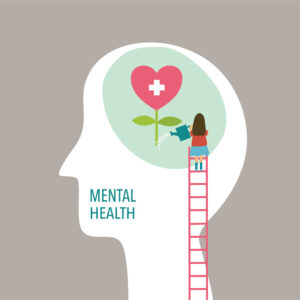Although the COVID-19 pandemic has subsided, its effects linger. The pandemic changed the way we interact with each other, how and where we earn a living, how we spend our free time and how we approach a healthy lifestyle. Life today is different than it was five years ago.
“During the pandemic, people faced more isolation, worry and fear, and this has left residual health and wellness issues,” says Ginger Nicol, associate professor of psychiatry at Washington University School of Medicine in St. Louis. “People stayed at home more, and their circle of face-to-face relationships shrank. They became more sedentary, influencing mental and physical health and wellness.”
According to the Centers for Disease Control and Prevention (CDC) National Center for Health Statistics, approximately 12% of those surveyed aged 18 and older between 2019 and 2022 said they regularly had feelings of worry, nervousness or anxiety.
“These feelings can lead to more serious mental health issues,” Nicol says. “However, there are ways that can improve your overall health and wellness — both mental and physical — to result in more day-to-day enjoyment and [better] health, and ultimately result in a better quality of life. Choosing to add more movement and activity, increasing time spent with family, and taking time for personal reflection can all contribute to better health and happiness.”
The pandemic cannot be wholly blamed for a decline in people’s mental and physical health. Today’s society is less active and exponentially more sedentary than it was several decades ago. As a result, both physical and mental health issues have increased.
Even before the pandemic, most Americans sat in front of some type of screen for much of their waking hours. With COVID-19, dependence on screens and technology expanded to fill the boredom.
Feelings of isolation and angst were magnified by less time outdoors and with family and friends. Depression, weight gain and other factors contributed to a decrease in physical fitness.
“Physical and mental health are inseparable,” Nicol says. “Research has shown that active people tend to have a better mental outlook and lead more enjoyable lives. The reverse is also true. People with a positive outlook are more likely to participate in some sort of regular activity.”
What is wellness?
Numerous factors contribute to a healthy life, from nutrition and being active to getting enough sleep and managing the aging process. Wellness encompasses both physical and mental health, and taking care of both mind and body promotes a balanced lifestyle.
“Our needs change as we grow older,” Nicol says. “It’s important to be aware of these changes and how we can address and adjust to them without compromising our wellness. Being responsible for our aging can help us reduce risk of disease, such as diabetes, stroke, heart attack and cardiovascular issues, depression and anxiety.”
Many things can contribute to a longer and more fulfilling life, such as regular wellness visits with a primary care physician to stay on top of potential health concerns; completing age-appropriate testing, such as colonoscopies and cancer screenings; and being willing to adjust eating, behavior and lifestyle habits.
“Prevention is the best approach to manage aging, and the sooner you can identify an issue, the better chance you have of making a meaningful change,” Nicol says. “Starting good behavioral practices for both physical and mental health can help your body and mind be more resilient and handle more serious challenges.”
Physical improvements
Making small physical changes to add movement every day is one of the first ways to improve health and fitness. Getting up from a chair can be a revealing way to test physical ability.
“Some people simply cannot rise from a seated position without either using their arms to push themselves up or rocking several times to gain momentum,” Nicol says. “I’ve seen people in their 30s and 40s who have difficulty standing from sitting in a chair or on the sofa. If this is difficult for you, it’s a good idea to practice a little every day until you can rise unassisted.
“As we age, our muscles lose mass and volume, plus our tendons get tighter. By tackling this basic movement, you can begin to increase your physical strength and mobility, as well as improve your balance and help prevent falls.”
According to the CDC, one in five falls causes serious injuries. Each year, more than 3 million older people are treated in emergency departments for fall injuries, which are the most common cause of traumatic brain injuries.
Falls are one of the main causes of nonfatal and fatal injuries. Whether they’re caused by tripping, losing balance, vision problems or health problems, they can result in broken bones, head injuries, cuts and bruising.
“Simple things — like practicing standing on one foot while brushing your teeth — can help improve your general core strength,” Nicol says. “If you can improve your ability to stand up from sitting and also increase your confidence in your balance, you’re making good headway toward a healthier and safer life.”
Brain health
Technology is a huge distraction in creating a healthy life. It can prevent people from relaxing, letting go of anxieties or working through challenges.
“Train your brain to let go of external diversions by turning off your smartphone, taking a walk in a park without handheld devices or simply finding a quiet place to sit and daydream for a bit,” Nicol says. “Daydreaming can be a powerful tool to help your brain slow down to the external stimuli and allow you to notice things you’d ordinarily glance over.”
Nicol suggests using a positive trigger to help increase awareness and to help with relaxing.
“Perhaps you’ve gone on a vacation and remember a pleasant sight, sound or feeling that can take you back to that time — the deep blue of the ocean, the sound of leaves rustling on a chilly fall day or seeing a stunning sunset,” she says. “Use that to disconnect from the worries of the day and reconnect with yourself.”
Other ways to unwind can include reading just for fun, spending an hour in the garden, pursuing a favorite hobby or experiencing a new one as a way to give your mind a rest.
“We spend our lives in front of screens, and we just don’t get outside enough to simply reflect and be present in the moment,” Nicol says. “Some people meditate, others practice yoga, but the secret is to find a way to slow down your brain waves and clear your mind. Give it time to refresh, and you’ll be surprised how much happier you can be.”
Health and wellness are parts of life’s journey that require heightened awareness and a commitment to make changes when necessary.
“Adding more movement each day, taking time to build meaningful social connections and allowing yourself to unplug from time to time can do wonders for your mental and physical health,” Nicol says.
Mental health resources
If you are thinking about suicide, worried about a friend or loved one, or in need of emotional support, reach out to the 988 Suicide & Crisis Lifeline. Call or text 988 or go to 988lifeline.org.
Find a comprehensive list of topics related to mental health, including eating disorders, helping a loved one cope with mental illness and warning signs of mental illness, at psychiatry.org/patients-families.
Watch YouTube videos that cover topics such as, “What Is Anxiety?” “An Overview of Depression,” “Social Media and Children’s Mental Health” and “What Is Addiction?” at youtube.com/@AmericanPsychiatricAssociation.
Read up on suicide prevention information, from the risk factors and warning signs to action steps to help someone in emotional pain, at psychiatry.org/Patients-Families/Suicide-Prevention.
Source: American Psychiatric Association, psychiatry.org










